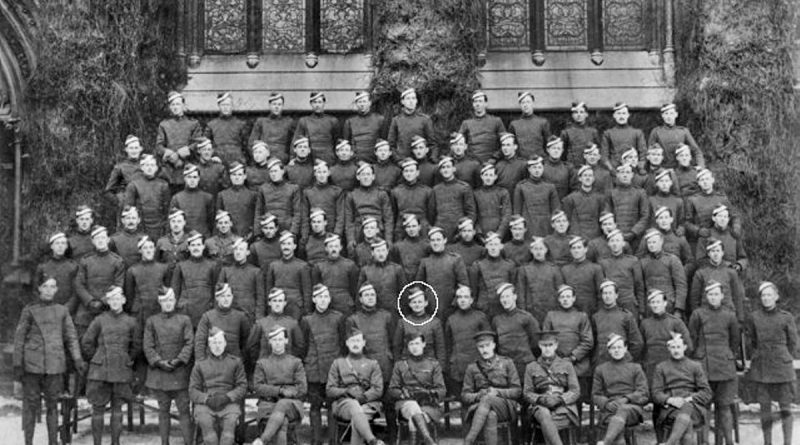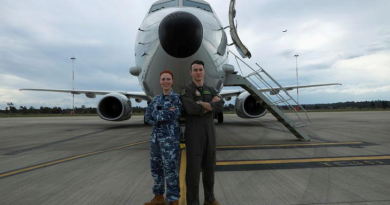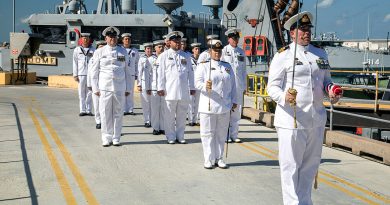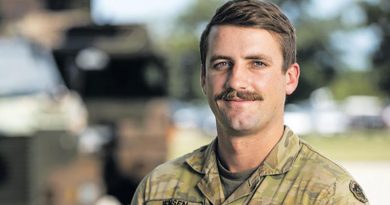Feeling the weight of a military legacy – Anzac Day
Share the post "Feeling the weight of a military legacy – Anzac Day"

A pilgrimage to Anzac Cove prompted Leading Seaman Peta Binns to reflect on the sacrifice and valour etched into her family’s history.
CAPTION: Leading Seaman Peta Binns’ great-great uncle, 2nd Lieutenant George Oakley Newton, is circled in a photo of his cadet class. Story by Leading Seaman Peta Binns. Photo supplied by Australian War Memorial (P00864.001).
Amid the echoes of haunting bugle calls and the sea crashing against the Gallipoli shoreline, I found myself immersed in a moving Anzac Day dawn service, paying tribute to the sacrifice of those who fought in the Great War.
As a recent transfer from full-time service, I embarked on a personal journey to Europe that included a stop in Turkiye to interlace my family’s weighty military legacy with the soberness of the Anzac occasion.
Many members of my family have a story to tell about their own service, but the one that sprang to mind on Anzac Day was that of my great-great uncle, 2nd Lieutenant (2LT) George Oakley Newton, who was first a soldier of the 15th Infantry Battalion in the Australian Imperial Force (AIF) and later a gallant figure in the Royal Flying Corps in World War 1.
2LT Newton was brother to my great-grandmother, uncle to my father’s father. His legacy is preserved through his AIF service record, a window into an era when courage was tested in the horrors of conflict.
His brother, Private William Newton, also a soldier of the 25th Battalion, was killed in action in France on March 1, 1917, shortly before his 20th birthday.
2LT Newton came from Toowoomba, Queensland. Learning more about him this year, I was intrigued to find that he enlisted in July 1915 and was a lance corporal, serving through the Pozieres battles, prior to joining the Royal Flying Corps. His daring exploits extended beyond the trenches, earning him a Distinguished Flying Cross and a place in aviation history.
Among the weathered pages of the London Gazette, the Edinburgh Gazette, The Queenslander extracts and military service records held by the Australian War Memorial, there was a photograph of 2LT Newton. He is circled in the image, with aviation pioneer Charles Kingsford-Smith standing just two places away.
Records revealed that during his posting to Royal Flying Corps’ 9 Squadron, 2LT Newton was awarded the Distinguished Flying Cross. His citation in November 1918 states: “During recent operations this officer has displayed conspicuous courage in attacking enemy troops and transport in the face of intense hostile fire. No difficulties daunt him, and he can always be relied upon to carry out the task allotted him.”
As is often the case, this doesn’t detail a particular story, so I did some further research, discovering that 9 Squadron was often faced with adversity. One incident involving 2LT Newton happened on Christmas Day in 1917, when some 9 Squadron aircraft were damaged during an artillery observation flight.
2LT Newton and colleague LT Reynolds had suffered undercarriage damage on a centre-section strut when landing during a hailstorm – one of the many unpredictable challenges faced by those who took to the skies.
As I stood amid generations of remembrance on the shores of Gallipoli, the rising sun cast a warm glow on the memorial, and I reflected on the weight of his honours, etched into our family history and the collective memory of a nation.
Anzac Day, for me, has become more than a commemoration. It is a connection to a past in which sacrifice and valour have defined my family legacy.
.
.

.
.
Share the post "Feeling the weight of a military legacy – Anzac Day"





